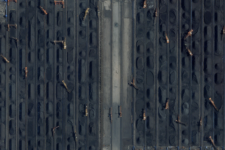
Synthetic Aperture Radar (SAR) satellites can “see” through clouds and at night. (Capella Space)
WASHINGTON: Capella Space will become the first synthetic aperture radar firm to demonstration optical link connectivity with the Space Development Agency’s Transport Layer of data relay satellites, the California startup announced today.
“Our team at Capella Space is thrilled to become the first commercial SAR company to demonstrate compatibility with the SDA’s National Defense Space Architecture and standards,” said Christian Lenz, CTO at Capella Space in a press release. “Enabling our satellites to integrate with the new SDA architecture efficiently is a critical step for us to work seamlessly with the U.S. defense and intelligence sector.”
Optical intersatellite links, or OISLs, use lasers to communicate and zip data between satellites on orbit — a technology that is both the central node and the biggest challenge in SDA’s effort to build a multi-layered National Defense Space Architecture in Low Earth Orbit (LEO) to provide both new capabilities and resiliency to DoD’s current space systems.
SDA’s architecture in turn is at the heart of DoD’s Joint All Domain Command and Control (JADC2) initiative to link all US military sensors with all shooters in near-real time in future globalized conflict with peer competitors across all domains — air, land, sea, space and cyberspace. At the same time, JADC2 also is crucial for the Space Force as it figures out how to “fight” in space and protect US satellites.
In the first Breaking Defense Space Survey, 69 percent of respondents reported that JADC2 is either “very” or “extremely” important to space warfare.
RELATED: Cyber concerns, classification disagreements lead Space Survey results
OISLs further are the focus of two other SDA experiments:
- Mandrake II: Two satellites, developed by DARPA and Air Force Research Laboratory (AFRL), to demo optical cross links between satellites. The birds were built by Astro Digital and carry an OSIL developed by SA Photonics, and are part of DARPA’s Blackjack program aimed at demonstrating the military utility of small, cheap satellites.
- Laser Interconnect and Networking Communication System (LINCS): Two OSIL demo sats being developed by General Atomics; these will be used to link to the MQ-9, not coincidently also built by GA.
“Capella Space will install optical communications terminals (OCTs) on its commercial SAR satellites, starting in late 2022,” according to the company’s announcement. “This will enable the company to utilize highly efficient laser communications technology to send and receive data to and from its satellites in low Earth orbit, relaying data to compatibly equipped government satellites and military operations on the ground.”
Capella is using Mynaric’s CONDOR Mk3 Optical Communications Terminal, which Mynaric has previously demonstrated is compatible with SDA systems and standards, the announcement added.
RELATED: Viasat to buy Inmarsat, plans for polar sats to expand Arctic coverage
“We are honored to be selected as the optical communications terminal vendor for Capella Space’s integration work with the SDA. The announcement today highlights the importance of standardization and compatibility within the industry,” said Bulent Altan, CEO of Mynaric.
An SDA spokesperson explained that the shared-cost agreement with Capella is separate from from its pending plans to launch 18 satellites, called Tranche 1 Demonstration and Experimentation System (T1DES), to carry experimental payloads developed by mission partners from industry and other government agencies. Under that effort, interested vendors had until yesterday to respond to the agency’s Oct. 8 draft request for proposals — with SDA planning to put out a final RFP early next year.






















